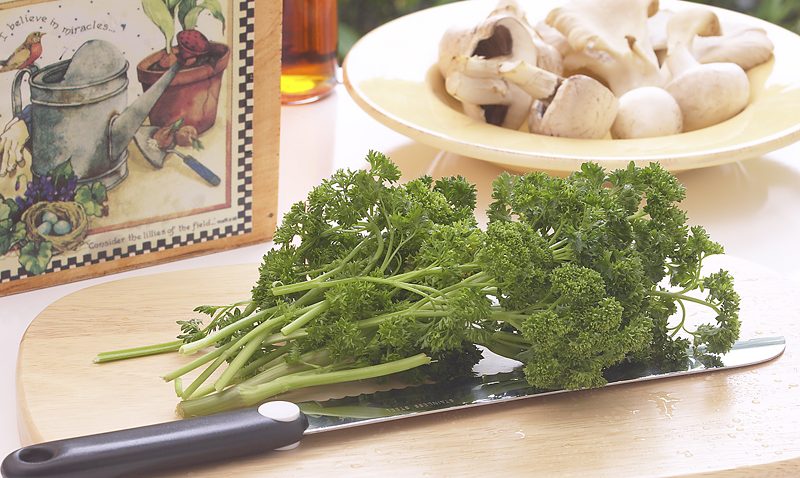As a child, I did not like mushrooms, and now I love them! Stuffed mushrooms are loaded with flavor. You can fill mushrooms with almost anything so experiment with different ideas and recipes.
NUTRITION
The nutritional value of mushrooms is greater than one may think! Although the nutritional info varies according to the type chosen, mushrooms are low in calories (about 21 per cup), low in carbohydrates, low in sodium, fat-free, cholesterol-free, and provide fiber. Mushrooms contain many important vitamins and minerals. They are a good source of B vitamins (riboflavin, niacin, and pantothenic acid), copper, and selenium.
PICKING OUT MUSHROOMS
When shopping, look for mushrooms big enough to hold the stuffing. Keep in mind mushrooms will reduce in size during cooking. White or brown button mushrooms can be used. Purchase them loose if you can. When choosing loose mushrooms, look for dry mushrooms with smooth caps, firm gills, and a fresh aroma. If packaged, look for signs of slime, mold, or shriveling, which indicates age. Choose firm, evenly colored mushrooms. The exact texture will depend upon the variety of mushrooms, but in general, mushrooms should be relatively firm, not limp or squishy.
STORING MUSHROOMS
Due to their high moisture content, mushrooms are very perishable. They can go from plump to shriveled and slimy in no time. Store loose mushrooms in a partially open zipper-lock bag, which maximizes air circulation without drying out the mushrooms. Leaving the bag slightly open allows for the release of the ethylene gas emitted from the mushrooms. Store packaged mushrooms in their original containers. These containers are designed to “breathe,” maximizing the life of the mushrooms by balancing the retention of moisture and the release of ethylene gas. If you open a sealed package of mushrooms but don’t use all the contents, simply rewrap the remaining mushrooms in the box with plastic wrap.
PREPARATION
Nothing is worse than biting into a stuffed mushroom that has a bit of grit in it! To prepare the mushrooms, I gently wipe them with a damp cloth. Don’t soak the mushrooms in water. They are very porous and will absorb water quickly. Absorbing too much water will alter their flavor and texture. Drying is important, as it will reduce the amount of liquid released while baking.
Remove the stems from the mushrooms. Save the stems for later use or freeze them. With a 1/4 teaspoon, small melon baller, or a tomato corer scoop out the inside of the mushroom.
Brush the mushrooms lightly with olive oil, so they don’t dry out in the oven. I pre-cook the mushrooms at 350°F for 15 – 20 minutes in a baking dish with sides so any liquid released does not spill in the oven before stuffing them. Then they are cooked again once stuffed. I do not want the mushroom to be undercooked. The result is perfectly cooked mushrooms that have a nice texture and great flavor, rather than being undercooked and watery. Make sure they are in a single layer, not piled on top of each other, so they evenly cook.
While they are roasting, prepare the filling. Taste it before actually filling all the mushrooms and cooking them. Adjust the seasoning and flavors.
STUFFING OPTIONS
What ingredients do you use to stuff mushrooms? Mushrooms are mild, so they need strong flavors to enhance them. There are many variations hence here are some ideas:
- Gouda cheese, bacon, onion, garlic, fresh spinach and breadcrumbs
- Crabmeat, bacon, breadcrumbs, and Monterey jack cheese
- Mild, hot, or sweet sausage, cream cheese, Parmesan cheese, onion, and garlic
- Brie cheese, onion, garlic, and parsley
- Sun-dried tomatoes, roasted red bell peppers, pine nuts, garlic, and parsley
- Butternut squash with goat cheese
- Marinated artichoke hearts, cream cheese, Italian cheese, onion, and garlic
- Avocado, prosciutto, basil, parsley, garlic, and onion
- Black olives, green olives, sun-dried tomatoes, garlic spread, basil, and pine nuts
- Pesto and Parmesan cheese
- Mexican chorizo, cheese, thyme
- Brie cheese and sun-dried tomatoes
- Quinoa, tomatoes, fresh mozzarella cheese, fresh basil, and balsamic glaze
- Pepperoni, green pepper, onion, cream cheese, parmesan, basil, oregano, and garlic
- Black beans, brown rice, salsa, cilantro, and queso fresco cheese
- Kalamata olives or regular black olives, Feta cheese, and Greek seasoning
If you have leftover stuffing mixture, use it to stuff mini bell peppers or serve with crackers!
A tasty way to prepare the mushroom stems is to chop them, and sauté them with garlic butter. Next, add a touch of heavy cream and a pinch of thyme. Put the mushroom stems on toast or crackers. Yum right?
Remove the mushroom caps from the oven, much of the water will have come out of the mushrooms; drain that water, and set the mushroom caps aside to cool.
Spoon the stuffing into the mushroom caps.
Roast the mushrooms for another 15 minutes at 350°F, and then under the broiler for 3 – 5 minutes until the tops are slightly browned and crispy. Serve right away while they’re piping hot!
Mushrooms are best eaten right after cooking, or the flesh will darken and not be as appealing. This does not matter so much if you are using them in a sauce, but for appetizers, such as stuffed mushrooms, appearance is more important.
Stuffed mushrooms are a classic, timeless, easy-to-make appetizer that can be enjoyed any time during the year!
Written by Vicki Hayman, MS, University of Wyoming Extension Nutrition and Food Safety Educator